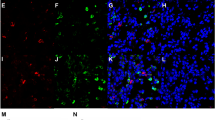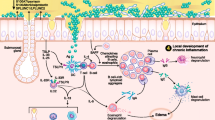Abstract
Purpose of Review
To review innate lymphoid cells (ILCs) and their role in chronic rhinosinusitis (CRS).
Recent Findings
The immune system consists of the innate and adaptive response. Until the recognition of ILCs, chronic inflammatory diseases were characterized by cytokines linked only to T helper cells. However, these immune responses are now described more broadly to include contributions from both the innate and adaptive immunity. In CRS, focus had been on ILC2s in CRS with nasal polyps. These studies also highlight the importance of epithelial cell–derived cytokines in coordinating these responses. In addition to indirect crosstalk via cytokines, ILCs and T helper cells can utilize the OX40/OX40 ligand and major histocompatibility complex class II pathways to directly interact and coordinate responses.
Summary
In addition to T helper cells, ILCs contribute to the inflammatory response associated with CRS. The understanding of these cells along with pathways that activate and perpetuate these cells leads to new potential therapeutic targets for CRS treatment.


Similar content being viewed by others
References
Papers of particular interest, published recently, have been highlighted as: • Of importance
Rudmik L. Economics of chronic rhinosinusitis. Curr Allergy Asthma Rep. 2017;17(4):20.
Kamil A, Ghaffar O, Lavigne F, Taha R, Renzi PM, Hamid Q. Comparison of inflammatory cell profile and Th2 cytokine expression in the ethmoid sinuses, maxillary sinuses, and turbinates of atopic subjects with chronic sinusitis. Otolaryngol Head Neck Surg. 1998;118(6):804–9.
Daines SM, Orlandi RR. Inflammatory cytokines in allergy and rhinosinusitis. Curr Opin Otolaryngol Head Neck Surg. 2010;18(3):187–90.
Mjösberg J, Spits H. Human innate lymphoid cells. J Allergy Clin Immunol. 2016;138(5):1265–76.
• Vély F, Barlogis V, Vallentin B, Neven B, Piperoglou C, Ebbo M, et al. Evidence of innate lymphoid cell redundancy in humans. Nat Immunol. 2016;17(11):1291–9 This prospective observational study follows a small cohort of SCID patients before and after hematopoietic stem cell transplantation, which reconstituted the T cells without much effect on the ILC population. With follow-up from 7 to 39 years, there were no increase in susceptibility to diseases as compared to control cohort with intact T cell and ILC populations. This suggests that for immune homeostasis, ILCs may be redundant to T cells.
Weizman OE, Adams NM, Schuster IS, Krishna C, Pritykin Y, Lau C, et al. ILC1 confer early host protection at initial sites of viral infection. Cell. 2017;171(4):795–808.
Klose CS, Artis D. Innate lymphoid cells as regulators of immunity, inflammation and tissue homeostasis. Nat Immunol. 2016;17(7):765–74.
Peters CP, Mjösberg JM, Bernink JH, Spits H. Innate lymphoid cells in inflammatory bowel diseases. Immunol Lett. 2016;172:124–31.
Forkel M, Mjosberg J. Dysregulation of group 3 innate lymphoid cells in the pathogenesis of inflammatory bowel disease. Curr Allergy Asthma Rep. 2016;16(10):73.
Bernink JH, Peters CP, Munneke M, te Velde AA, Meijer SL, Weijer K, et al. Human type 1 innate lymphoid cells accumulate in inflamed mucosal tissues. Nat Immunol. 2013;14(3):221–9.
Barlow JL, Bellosi A, Hardman CS, Drynan LF, Wong SH, Cruickshank JP, et al. Innate IL-13-producing nuocytes arise during allergic lung inflammation and contribute to airways hyperreactivity. J Allergy Clin Immunol. 2012;129:191–198. e1–4.
Halim TY, Krauss RH, Sun AC, Takei F. Lung natural helper cells are a critical source of th2 cell-type cytokines in protease allergen-induced airway inflammation. Immunity. 2012;36:451–63.
Kim HY, Umetsu DT, Dekruyff RH. Innate lymphoid cells in asthma: will they take your breath away? Eur J Immunol. 2016;46(4):795–806.
Endo Y, Hirahara K, Iinuma T, Shinoda K, Tumes DJ, Asou HK, et al. The interleukin-33-p38 kinase axis confers memory T helper 2 cell pathogenicity in the airway. Immunity. 2015;42:294–308.
Dietz CP, Luong A. Innate lymphoid cells: the innate counterpart to T helper cells. Adv Otorhinolaryngol. 2016;79:58–68.
Dietz CJ, Yadav A, Fakhri S, Citardi MJ, Luong A. Innate lymphoid cell distributions in chronic rhinosinusitis subtypes. Communication presented at the Cell-VIB-Symposia: the multifaceted roles of type 2 immunity held in Bruges, Belgium. 2014
Mjösberg JM, Trifari S, Crellin NK, Peters CP, van Drunen CM, Piet B, et al. Human IL-25- and IL-33-responsive type 2 innate lymphoid cells are defined by expression of CRTH2 and CD161. Nat Immunol. 2011;12(11):1055–62.
Shaw JL, Fakhri S, Citardi MJ, Porter PC, Corry DB, Kheradmand F, et al. IL-33-responsive innate lymphoid cells are an important source of IL-13 in chronic rhinosinusitis with nasal polyps. Am J Respir Crit Care Med. 2013;188(4):432–9.
• Tojima I, Kouzaki H, Shimizu S, Ogawa T, Arikata M, Kita H, et al. Group 2 innate lymphoid cells are increased in nasal polyps in patients with eosinophilic chronic rhinosinusitis. Clin Immunol. 2016;170:1–8 Using flow cytometry analysis, the authors analyzed the prevalence of ILC2s within inflamed sinus mucosa and peripheral from healthy controls, eosinophilic, and non-eosinophilic CRSwNP and CRSsNP patients. They confirmed an elevated prevalence of ILC2s in CRSwNP but showed a correlation of elevated ILC2s and eosinophilic CRSwNP. This correlation suggests a role of ILC2s in support and recruitment of eosinophils to sinus mucosa.
Ho J, Bailey M, Zaunders J, Mrad N, Sacks R, Sewell W, et al. Group 2 innate lymphoid cells (ILC2s) are increased in chronic rhinosinusitis with nasal polyps or eosinophilia. Clin Exp Allergy. 2015;45(2):394–403.
Roediger B, Weninger W. Group 2 innate lymphoid cells in the regulation of immune responses. Adv Immunol. 2015;125:111–54.
Schmitz J, Owyang A, Oldham E, Song Y, Murphy E, McClanahan TK, et al. IL-33, an interleukin-1-like cytokine that signals via the IL-1 receptor-related protein ST2 and induces T helper type 2-associated cytokines. Immunity. 2005;23(5):479–90.
Chen WY, Tsai TH, Yang JL, Li LC. Therapeutic strategies for targeting IL-33/ST2 signalling for the treatment of inflammatory diseases. Cell Physiol Biochem. 2018;49(1):349–58.
Torgerson DG, Ampleford EJ, Chiu GY, et al. Meta-analysis of genome-wide association studies of asthma in ethnically diverse North American populations. Nat Genet. 2011;43:887.
• Camelo A, Rosignoli G, Ohne Y, Stewart RA, Overed-Sayer C, Sleeman MA, et al. IL-33, IL-25, and TSLP induce a distinct phenotypic and activation profile in human type 2 innate lymphoid cells. Blood Adv. 2017;1(10):577–89 In this study, human ILC2s were isolated and cultured in vitro to dissect the individual and combined effects of IL-33, IL-25, and TSLP on ILC2s. In addition, these studies observed the plasticity of ILC2s.
Kouzaki H, Matsumoto K, Kikuoka H, Kato T, Tojima I, Shimizu S, et al. Endogenous protease inhibitors in airway epithelial cells contribute to eosinophilic chronic rhinosinusitis. Am J Respir Crit Care Med. 2017;195(6):737–47.
Paris G, Pozharskaya T, Asempa T, Lane AP. Damage-associated molecular patterns stimulate interleukin-33 expression in nasal polyp epithelial cells. Int Forum Allergy Rhinol. 2014;4(1):15–21.
Poposki JA, Klingler AI, Stevens WW, Peters AT, Hulse KE, Grammer LC, et al. Proprotein convertases generate a highly functional heterodimeric form of thymic stromal lymphopoietin in humans. J Allergy Clin Immunol. 2017;139(5):1559–67.
Nagarkar DR, Poposki JA, Tan BK, Comeau MR, Peters AT, Hulse KE, et al. Thymic stromal lymphopoietin activity is increased in nasal polyps of patients with chronic rhinosinusitis. J Allergy Clin Immunol. 2013;132(3):593–600.
Van Dyken SJ, Nussbaum JC, Lee J, Molofsky AB, Liang HE, Pollack JL, et al. A tissue checkpoint regulates type 2 immunity. Nat Immunol. 2016;17(12):1381–7.
Halim TY, Hwang YY, Scanlon ST, Zaghouani H, Garbi N, Fallon PG, et al. Group 2 innate lymphoid cells license dendritic cells to potentiate memory TH2 cell responses. Nat Immunol. 2016;17(1):57–64.
• Halim TYF, Rana BMJ, Walker JA, Kerscher B, Knolle MD, Jolin HE, et al. Tissue-restricted adaptive type 2 immunity is orchestrated by expression of the costimulatory molecule OX40L on group 2 innate lymphoid cells. Immunity. 2018;48(6):1195–207 This study demonstrated that IL-33 incited tissue-restricted expression of OX40L on ILC2s, which resulted in expansion of T helper and Treg cells. In a mouse model of parasitic infection using Nippostrongylus brasiliensis, abolishing OX40L ILC2s resulted in an inability to mount an effective Th2 and Treg cell response. This demonstrated the importance of the crosstalk between ILC2s and adaptive immune response.
Oliphant CJ, Hwang YY, Walker JA, Salimi M, Wong SH, Brewer JM, et al. MHCII-mediated dialog between group 2 innate lymphoid cells and CD4(+) T cells potentiates type 2 immunity and promotes parasitic helminth expulsion. Immunity. 2014;41(2):283–95.
Mirchandani AS, Besnard AG, Yip E, Scott C, Bain CC, Cerovic V, et al. Type 2 innate lymphoid cells drive CD4+ Th2 cell responses. J Immunol. 2014;192(5):2442–8.
Author information
Authors and Affiliations
Ethics declarations
Conflict of Interest
The authors declare no conflict of interest relevant to this manuscript.
Human and Animal Rights and Informed Consent
Patients undergoing medically indicated functional endoscopic sinus surgery (FESS) were consented to having sinonasal tissue, which was removed as a standard of their surgery, collected and analyzed for studies shown in Fig. 2. The Institutional Review Board at the University of Texas Health Science Center at Houston approved the study protocol.
Additional information
Publisher’s Note
Springer Nature remains neutral with regard to jurisdictional claims in published maps and institutional affiliations.
This article is part of the Topical Collection on Rhinosinusitis
Rights and permissions
About this article
Cite this article
Luong, A.U., Sun, H. & Yao, W.C. Contributions of Innate Lymphoid Cells in Chronic Rhinosinusitis. Curr Allergy Asthma Rep 19, 28 (2019). https://doi.org/10.1007/s11882-019-0861-7
Published:
DOI: https://doi.org/10.1007/s11882-019-0861-7




